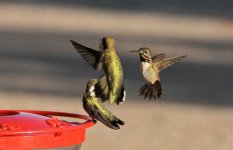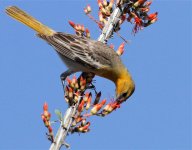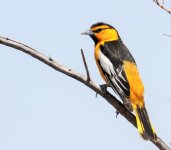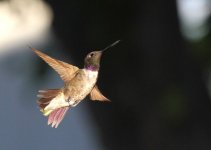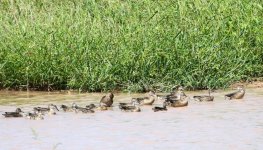Al Hansen
Well-known member
Yesterday, 8-8-22, after supper, I decided to try and take some hummingbird pictures. I was using my new used Canon 7D that I got in the mail just a week ago. Since the light was going to be an issue maybe, I decided to use my 70mm-200mm f4 L lens. It is a fast lens and I'm pleased with some of the shots I get.
When I finished my shoot, I decided to sit in front of the computer to see what I got. Here is the picture I happened to like for more than just one reason.
This has been a very good year for hummers where Bev and I live, which is just south of Socorro, NM. For almost a week now the hummers have been going through at least 1 gallon of nectar per day. Lately, I have had to add another quart so it is up to 5 a day now. It has been quite a few years since we have had this many hummers show up at our home. Before I forget, on their migration south, which is what is going on now, we have at least four varieties that stop to refuel. They are; black-chinned, broadtail, calliope, and rufous. That is a great collection for this amazing little tyke that give us so much pleasure.
Al
Here is a male black-chinned hummingbird who is definitely involved with the Ooopps, scenario. This particular hummingbird feeder has 6 feeding stations and a 3/16th " plastic coated rail that they can sit on if they care to. Some prefer to fly while feeding. Please remember that hummers lick the nectar. They have the ability to flick their tongue out and in up to 16 times per second. If you click on the picture it will expand in size. Enjoy.

When I finished my shoot, I decided to sit in front of the computer to see what I got. Here is the picture I happened to like for more than just one reason.
This has been a very good year for hummers where Bev and I live, which is just south of Socorro, NM. For almost a week now the hummers have been going through at least 1 gallon of nectar per day. Lately, I have had to add another quart so it is up to 5 a day now. It has been quite a few years since we have had this many hummers show up at our home. Before I forget, on their migration south, which is what is going on now, we have at least four varieties that stop to refuel. They are; black-chinned, broadtail, calliope, and rufous. That is a great collection for this amazing little tyke that give us so much pleasure.
Al
Here is a male black-chinned hummingbird who is definitely involved with the Ooopps, scenario. This particular hummingbird feeder has 6 feeding stations and a 3/16th " plastic coated rail that they can sit on if they care to. Some prefer to fly while feeding. Please remember that hummers lick the nectar. They have the ability to flick their tongue out and in up to 16 times per second. If you click on the picture it will expand in size. Enjoy.



